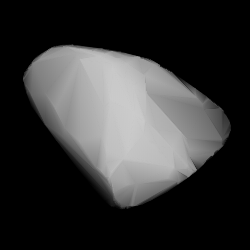Top Qs
Timeline
Chat
Perspective
4489 Dracius
Jupiter trojan (asteroid) From Wikipedia, the free encyclopedia
Remove ads
4489 Dracius, (prov. designation: 1988 AK), is a large Jupiter trojan from the Greek camp, approximately 90 kilometers (56 miles) in diameter. It was discovered on 15 January 1988, by American astronomer Edward Bowell at the Anderson Mesa Station of the Lowell Observatory near Flagstaff, Arizona, in the United States.[1] The dark D-type asteroid belongs to the 50 largest Jupiter trojans and has a rotation period of 12.58 hours.[4] It was named after Dracius from Greek mythology, who was a commander of the Epeans who fought against Hector.[2]
Remove ads
Orbit and classification
Dracius is a dark Jovian asteroid orbiting in the leading Greek camp at Jupiter's L4 Lagrangian point, 60° ahead of its orbit in a 1:1 resonance (see Trojans in astronomy). It is a non-family asteroid in the Jovian background population.[6][17] It orbits the Sun at a distance of 4.9–5.5 AU once every 11 years and 11 months (4,354 days; semi-major axis of 5.22 AU). Its orbit has an eccentricity of 0.06 and an inclination of 22° with respect to the ecliptic.[3]
The body's observation arc begins with its first observation as 1980 KA1 at Crimea–Nauchnij in May 1980, almost 8 years prior to its official discovery observation at Anderson Mesa.[1]
Remove ads
Numbering and naming
This minor planet was numbered on 8 June 1990 (M.P.C. 16414).[18] As of 2018, it had not been named.[1] On 14 May 2021, the object was named by the Working Group for Small Bodies Nomenclature (WGSBN), after Dracius from Greek mythology, who was a commander of the Epeans of Elis, who defended the Argive ships from Hector's attack during the Trojan War.[2]
Before Dracius was named, it belonged to a small group of only 8 unnamed minor planets with a designated number smaller than 5000. (All of them are Jupiter trojans or near-Earth asteroids). Since then, several have been named :
- 3708 Socus (3708) 1974 FV1 – named in May 2021
- 4035 Thestor (4035) 1986 WD – named in May 2021
- 4489 Dracius (4489) 1988 AK – named in May 2021
- (4596) 1981 QB
- (4688) 1980 WF
- 4715 Medesicaste (4715) 1989 TS1 – named in May 2021
- 4835 Asaeus (4835) 1989 BQ
- (4953) 1990 MU
Remove ads
Physical characteristics
Summarize
Perspective
In the SDSS-based taxonomy, as well as in both the Tholen- and SMASS-like taxonomy of the Small Solar System Objects Spectroscopic Survey (S3OS2), Dracius is a dark D-type asteroid.[14][17][15] It has also been characterized as a D-type by Pan-STARRS' survey.[4][16]
On 18 December 2012, 1988 AK has occulted the star TYC 2467-00054-1 over parts of the United States. The asteroid's brightness was measured at 16.1 and that of the star at 11.1 magnitude.[19]
Rotation period
Since 1992, several rotational lightcurves of Dracius have been obtained from photometric observations by Stefano Mottola, as well as Daniel Coley and Robert Stephens at the Center for Solar System Studies, California, in collaboration with Linda French and Brian Warner. Lightcurve analysis gave a well-defined rotation period of 12.582 hours with a consolidated brightness amplitude between 0.20 and 0.26 magnitude (U=3/3).[4][10][11][12][13][a]
Diameter and albedo
According to the surveys carried out by the Japanese Akari satellite, the Infrared Astronomical Satellite IRAS, and the NEOWISE mission of NASA's Wide-field Infrared Survey Explorer, Dracius measures between 76.60 and 95.02 kilometers in diameter and its surface has an albedo between 0.050 and 0.069.[7][8][9]
The Collaborative Asteroid Lightcurve Link adopts the results obtained by IRAS, that is, an albedo of 0.0514 and a diameter of 92.93 kilometers based on an absolute magnitude of 9.0.[4]
100+ largest Jupiter trojans
Remove ads
Notes
- Lightcurve plots of (4489) 1988 AK (4489 Dracius) from March 2015 and April 2016 by Daniel Coley and Robert Stephens at the Center for Solar System Studies (U81)/(U80). Quality code is 3/3 (lightcurve rating at CS3). Summary figures at the LCDB and CS3.
References
External links
Wikiwand - on
Seamless Wikipedia browsing. On steroids.
Remove ads

